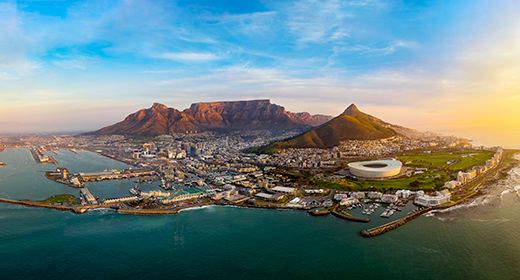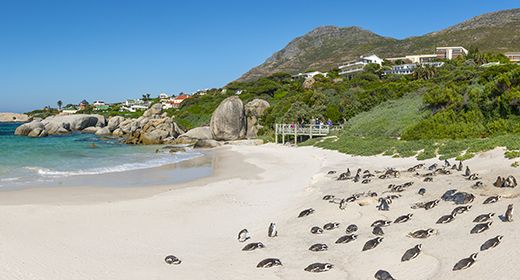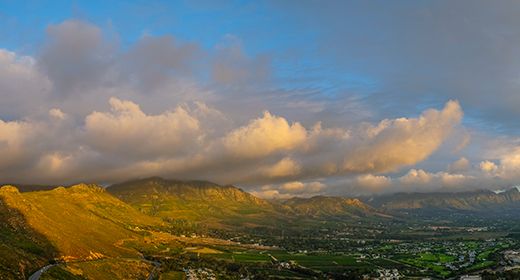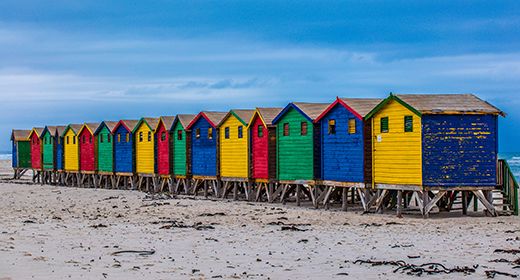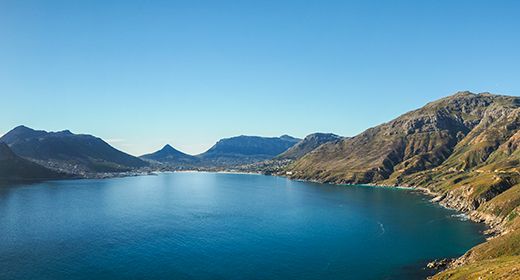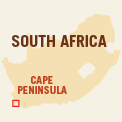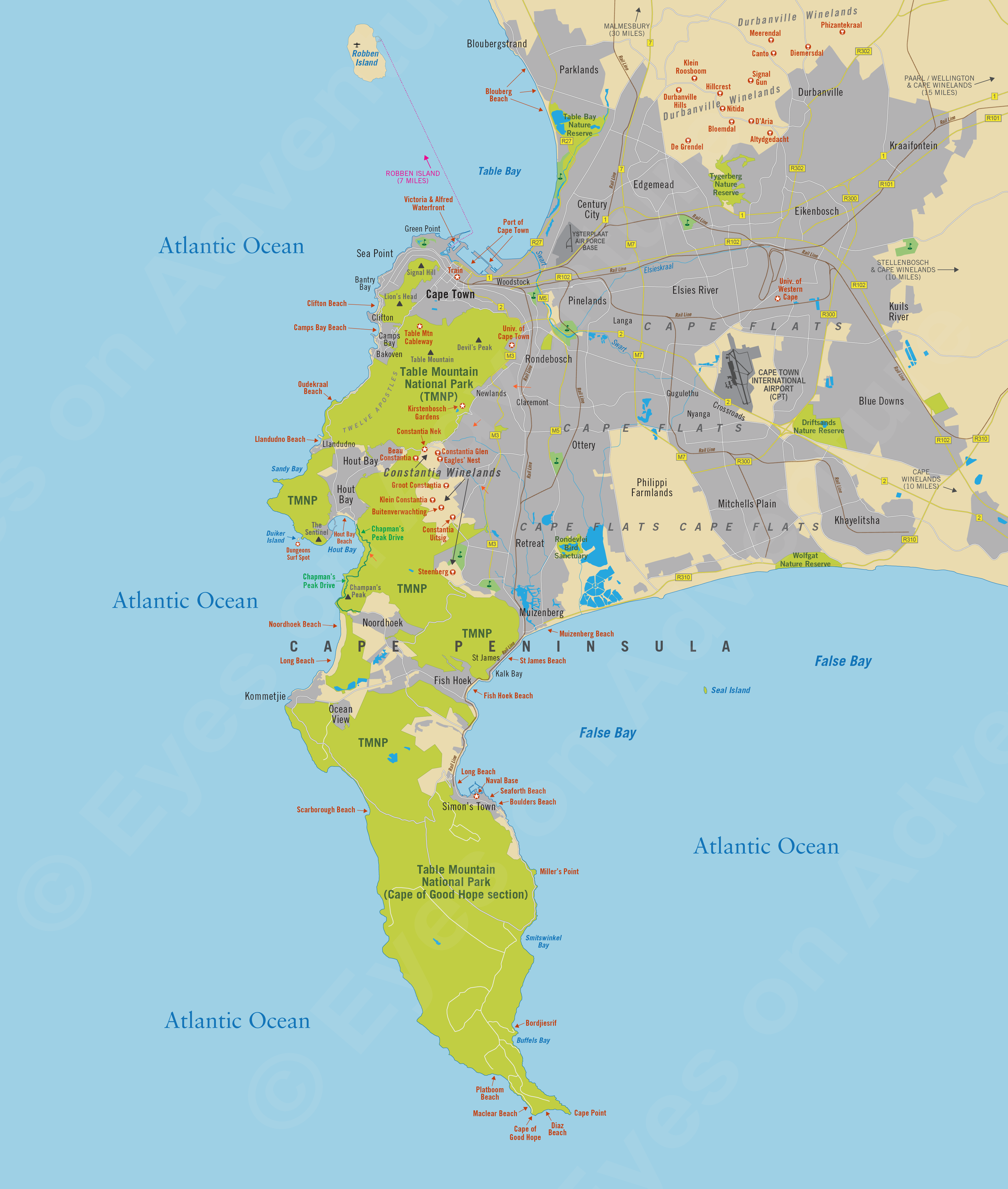Cape Peninsula
(incl. Cape Town, Table Mountain, Constantia Winelands, Durbanville Winelands)
Region Links: Cape Peninsula, Cape Town, Cape West Coast, Cape Winelands, Eastern Cape, Garden Route, Gauteng Province, Johannesburg, Kruger Park & Lowveld, Kruger Private Reserves, KwaZulu-Natal, Madikwe, Overberg & Whale Coast, Pilanesberg & Sun City, Sabi Sand Reserve
Highlights
- Explore the Constantia Winelands to see the 300+-year-old estates and delicious wines
- Take the cablecar or hike to the top of Table Mountain for spectacular views
- Travel to the southern tip of the peninsula for Cape Point and the Cape of Good Hope
- Tour Robben Island where Nelson Mandela was imprisoned for 18 years
- Spend a day on one of the many beautiful beaches along the peninsula
EOA Recommends: The Last Word Constantia, The Twelve Apostles Hotel & Spa, Tintswalo Atlantic
South Africa's Cape Peninsula is home to Cape Town, the so-called Mother City. There is no other city like it on the African continent and, unlike most African cities, it is a destination well worth adding to your itinerary.
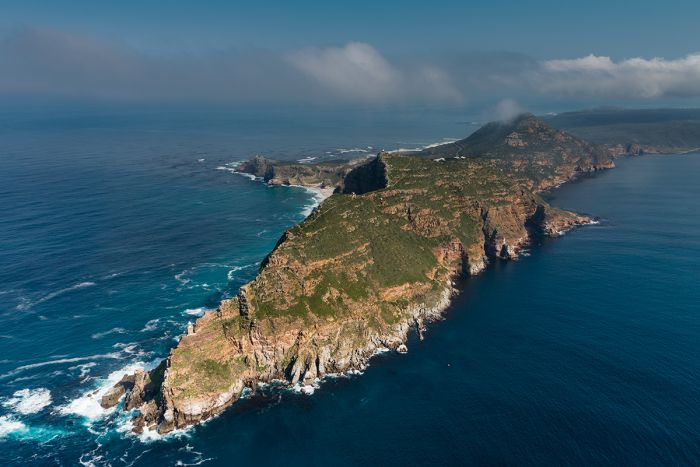
Cape Point at the southern end of the Cape Peninsula, South Africa
The dominating feature of the Cape Peninsula is Table Mountain, a 3 563-foot (1 086-meter) flat-topped massif that presides over Cape Town. Riding on the cableway to the top and taking in the spectacular views over the city and ocean is a must-do.
Robben Island, South Africa's version of Alcatraz, is the offshore prison where Nelson Mandela spent 18 of his 27 years of incarceration. It is now a tremendously popular tourist attraction and tours are offered several times each day, leaving from the Victoria & Alfred Waterfront.
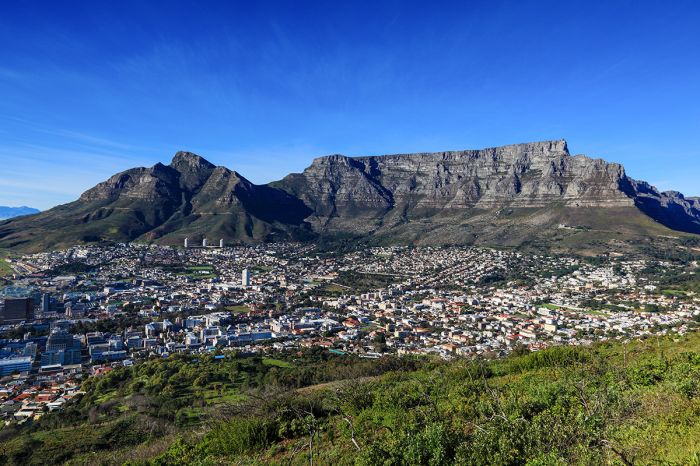
Table Mountain and Cape Town on the Cape Peninsula, South Africa
Table Mountain National Park encompasses much of the peninsula and drives down the coast, especially along Chapman's Peak Drive, offer jaw-dropping views that just keep coming. The Cape of Good Hope and Cape Point lie at the southern tip of the peninsula and should not be missed. A round-trip drive of the peninsula is very likely to be a highlight of any visit to the Cape.
For those wanting adrenaline, consider a shark cage-diving excursion, leaving from Simon's Town and heading to Seal Island in False Bay, where white sharks hunt Cape fur seals. Afterwards, take in the quaint fishing village of Kalk Bay and visit the African penguin colony at Boulders Beach.
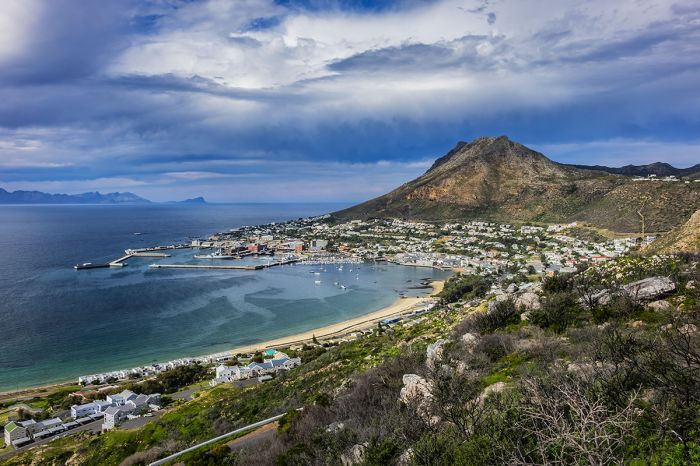
View over Simon's Town and False Bay
Wine lovers can visit two distinct wine regions right outside Cape Town. Constantia is only a 30-minute drive southeast from Cape Town and boasts some of the country's oldest wine estates, as well as numerous fine dining options. The Durbanville Valley on the northern outskirts of the city produces excellent whites in one of the country's coolest wine-producing regions.
Whatever you do when planning a trip to South Africa, do not overlook this unique destination. It offers culture, history, dining, adventure, outdoor activities, and unending natural beauty. No matter how long your visit, you will surely leave wanting more.
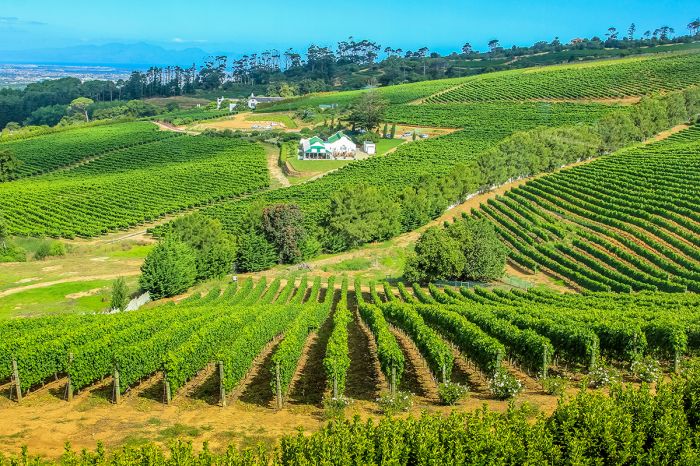
Centuries-old vineyards in Constantia, Cape Peninsula, South Africa
Read more...
Beaches, Blouberg Beach, Cape Flats, Cape Floral Kingdom, Cape of Good Hope, Cape Peninsula, Cape Point, Cape Town, Chapman's Peak, Constantia Winelands, Durbanville Winelands, Fish Hoek, Hout Bay, Kalk Bay, Khayalitsha, Kirstenbosch Garden, Muizenberg, Robben Island, Sharks, Simon's Town, Table Mountain
The Cape Peninsula
The narrow finger of land extending for 40 miles (60 kms) south of Cape Town is called The Cape Peninsula. The spine of the peninsula is dominated by a ridge of mountains that divides the coastal regions on either side - the wild and windy Atlantic Ocean to the west and the calmer False Bay to the east.
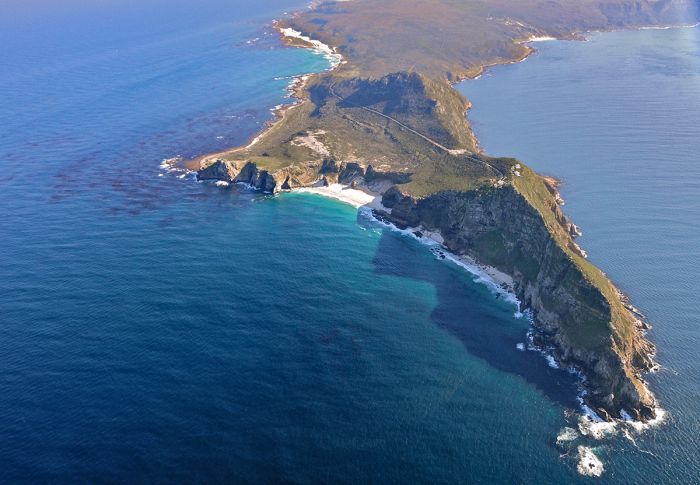
Aerial view of the Cape Peninsula with Cape Point, Cape of Good Hope, and Diaz Beach
Cape Point, the rocky strip of highland at the southern terminus of the peninsula, is often assumed to be the southernmost spot on the continent but it isn't - Cape Agulhas further east in the Overberg has that distinction. Nonetheless, a visit to the Point and its lighthouse is a must.
The majority of the peninsula is a dramatic landscape that includes spectacular natural beauty and rare floral diversity and, as such, is protected as the part of the disjointed Table Mountain National Park, which now covers roughly two-thirds of the peninsula.
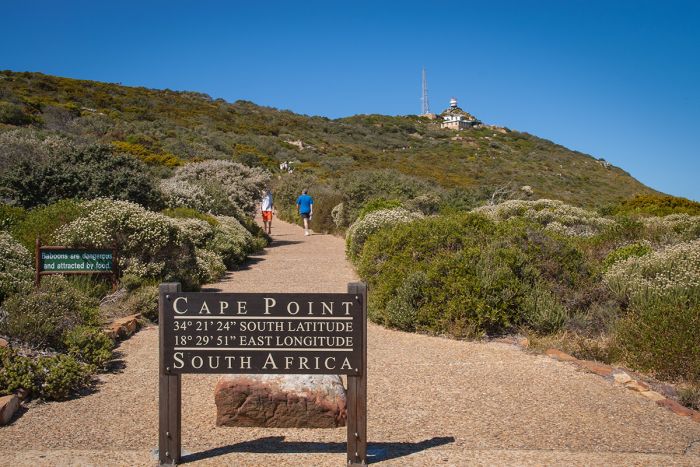
The trail leading to the original Cape Point lighthouse
Small coastal towns and secluded sand beaches are found along the mostly rocky shorelines and one can easily self-drive the peninsula on a round trip from Cape Town. Guided tours of the peninsula will give you all the sights, plus historic commentary along the way.
Cape Town
Africa's most loved urban destination is undoubtedly Cape Town. It offers an unmatched combination of history, outdoor adventure, and culture, all in one of the most naturally beautiful places on Earth. Click to read all about what to see and do in Cape Town.
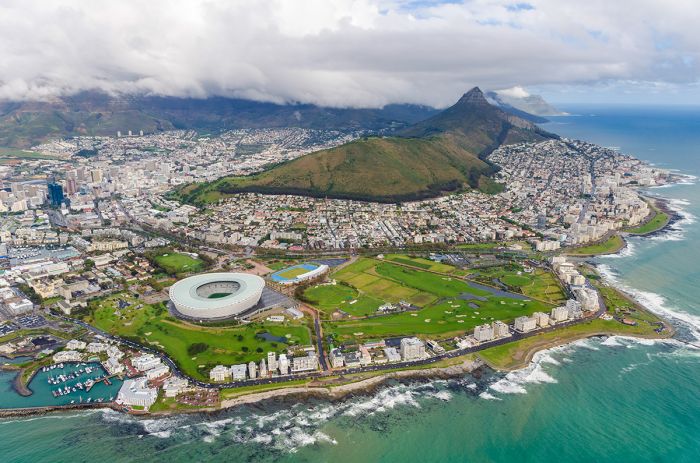
Aerial view of Cape Town showing Signal Hill and Lion's Head. Table Mountain in clouds.
Table Mountain
Table Mountain is one of Africa's most iconic geographic features and it is likely the first thing European explorers saw as their ships approached the southern end of the continent. The mountain is a sandstone plateau overlooking Table Bay and its distinctive flattened top is often covered by clouds (which locals refer to as 'the tablecloth'), but on clear days it can be viewed from many miles away.
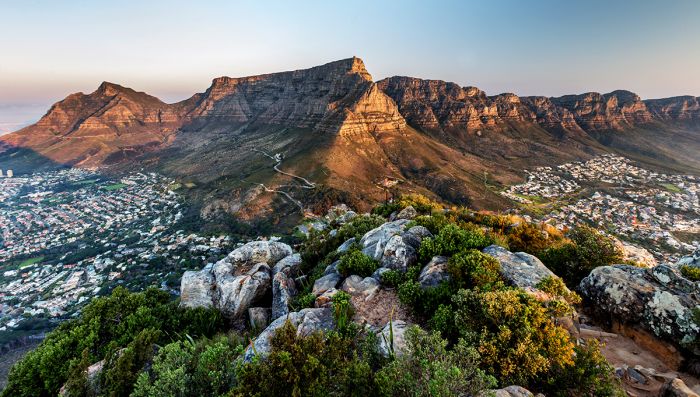
Table Mountain sunset - view from Lion's Head
Cape Town itself is surrounded on three sides by the mountains, with the flattened northern face of the Table presiding over the city centre and to the east, Devil's Peak, which overlooks the southeastern suburbs. A small valley separates the main massif from the peaks of Lion's Head and Signal Hill, which guard the western flank of the city.
The western face of the main massif is a series of buttresses referred to as The Twelve Apostles (note that there are actually 17 or 18 peaks that make up this formation, but perhaps 12 were originally considered as the larger peaks). Although not as high in elevation as the Table, they are spectacular and perhaps more impressive, with the ravines and ridges rising up right along the coast. The coastal road below requires concentration, as the views are incredible.
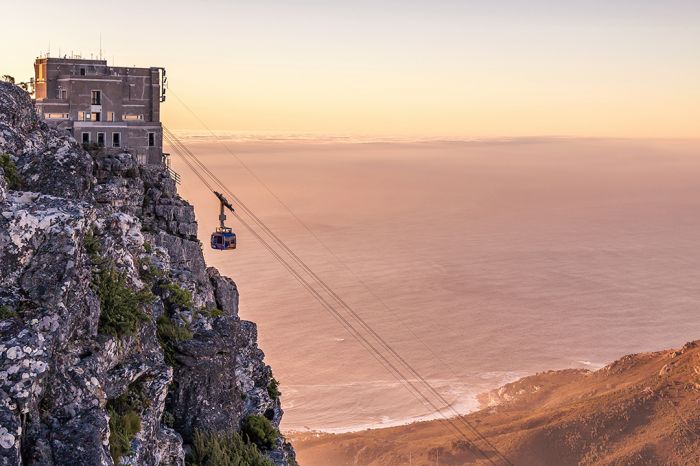
The upper cable station atop Table Mountain
Getting to the top of the Table can be done in two ways, the cableway or hiking on one of many trails. Climbing to the top is exhilarating and the trails are good, but fitness is required and is best done with a guide, as the weather on the mountain is notoriously fickle and can change in an instant.
The original cableway was opened in 1929 and the current system is state-of-the-art. The cable car ascends the Table on the northwest face, taking 5 minutes and making a full 360° rotation en route. The cableway operates daily, with departures every 10-15 minutes, but operations are sometimes disrupted by bad weather. Anyone visiting Cape Town should certainly make it to the Table top and experience the dizzying views. Sunsets from the upper cable station area are unbeatable. Buy your tickets beforehand and avoid weekends and holidays if possible, as the crowds can be large and the queues lengthy.
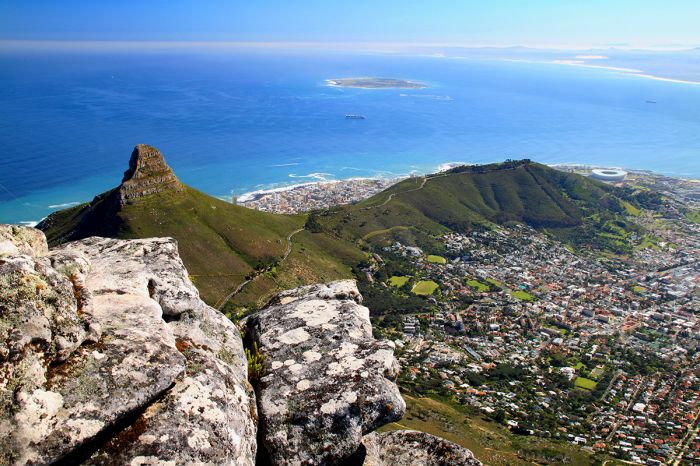
View from atop Table Mountain showing Cape Town, Robben Island, Lion's Head and Signal Hill
Wildlife is limited to rock hyrax, baboons, and birds. The hyrax (locally called a 'dassie'), resembles an oversized guinea pig, but is not a rodent at all, as its closest relative is the elephant! The plateau is also a refuge for protea flowers and myriad other 'fynbos' vegetation.
Signal Hill, detached from the Table, overlooks the west city from the west. A road leads to a carpark and lookout and affords breathtaking views in all directions. The name derives from a canon that was used to send signals to ships at anchor in Table Bay.
Lion's Head is situated just to the south and can be climbed in around 2 hours. A local tradition that brings out Capetonians in droves is climbing Lion's Head on full moon nights.
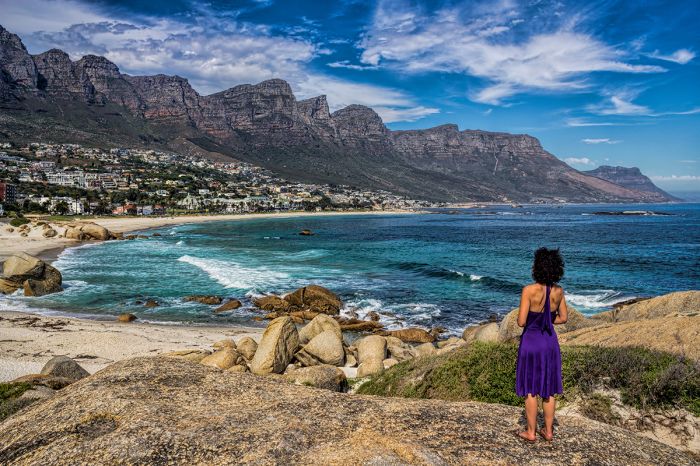
The Twelve Apostles mountains on the coast of the peninsula
Robben Island
Located 7 miles (12 kms) offshore in Table Bay, Robben Island gets its name (robben means seal in Dutch) from the seals that once lived there in the days when the Cape was first settled by the Dutch.
The island was used as a prison for hundreds of years and is well known for having been Nelson Mandela's home for 18 of his 27 total years of incarceration. Mandela was imprisoned on Robben Island from 1964 to 1982 for sabotage and conspiracy to overthrow South Africa's apartheid government. The island's first prisoner was banished here in 1658 and the 17th century saw many more political prisoners and Muslim clerics exiled to the island for opposing the Dutch rule.
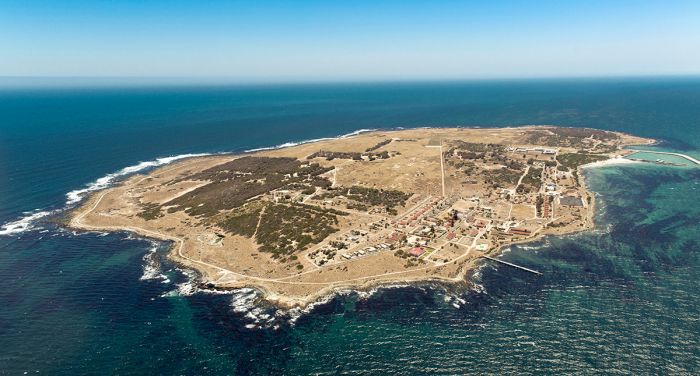
Aerial view over Robben Island
The last prisoners were transferred to the mainland in 1996 and a year later, the island was established as a museum. Robben Island was declared a UNESCO World Heritage Site in 1999.
Today the island is a major tourist attraction, with multiple 4-hour guided tours leaving daily from the Victoria & Alfred Waterfront. This is the only way to visit the island and the tours are led by former prisoners, who share their experiences along the way. The tours consist of a bus drive around the island followed by a walking tour of the prison. Tours are sometimes cancelled due to inclement weather.
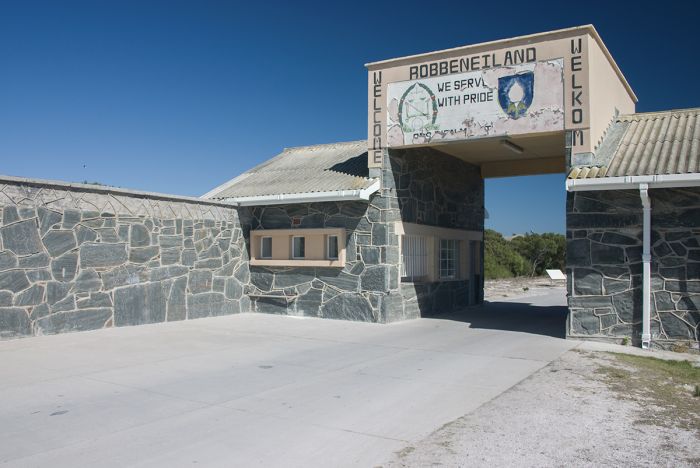
Robben Island is now a museum and UNESCO World Heritage Site
Constantia Winelands
Just 6 miles (10 kms) from Cape Town's city centre and south of Table Mountain lies the lovely Constantia Valley. The town of Constantia is the most upmarket of the Cape Town's southern suburbs and besides being home to some of the oldest wine estates in the country, it also boasts some of the best dining options in the Cape. For those who don't have time to visit the Cape Winlenads of Stellenbosch and Franschhoek, Constantia is an excellent compromise.
Simon van Der Stel, the first Governor of the Dutch Cape Colony, established a huge estate in the Constantia Valley in 1685 and planted the Cape's first grape vines. After the governor's death in 1712, his estate was divided and sold off, creating multiple estates, including Groot Constantia, Klein Constantia, and Buitenverwachting.
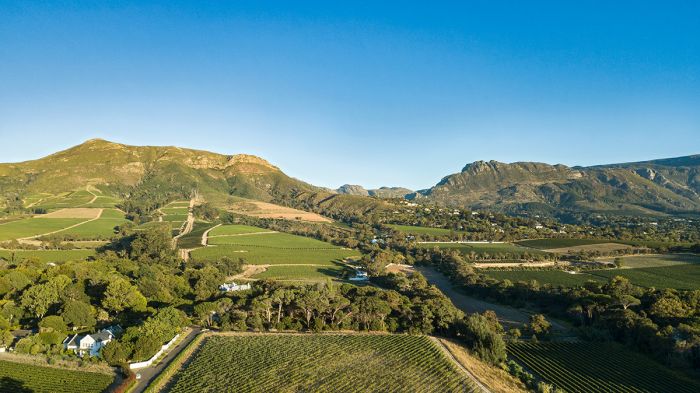
The Constantia Winelands and mountains
Our Winery Picks - Constantia
- Buitenverwachting: Part of the original Constantia farm. Absolutely spectacular setting w/oak-lined avenue leading past Cape Dutch homestead to a small cellar. Acres of vineyards on gorgeous hillsides. Superb wines, including flagship Bordeaux-style blend "Christine." Excellent restaurant. Name means 'beyond expectations'.
- Constantia Glen: Boutique estate with sweeping vistas of the valley's winelands. Large tasting room offering cheese plates and light snacks. Great Savignon Blanc.
- Groot Constantia: The heart of the original Constantia farm and a national monument. Enormous estate with Simon van der Stel's magnificent Cape Dutch-style homestead, now a museum. Original "Cloete" wine cellar, built in 1791, is now a tasting room. Award-winning Chardonnay. Two sophisticated restaurants offer meals and picnics.
- Klein Constantia: Part of the original Constantia farm. Best known for its 'Vin de Constance', a delicious and historic dessert wine that was a favorite of Napoleon, Frederick the Great, Bismarck, and the poet Baudelaire, who compared its sweetness to his lover's lips. Small bistro.
- Steenberg: The Cape's oldest farm, established in 1682. Modern lounge and tasting room. Excellent restaurant with stunning views. Excellent Merlot, Sauvignon Blanc, and sparking wine.
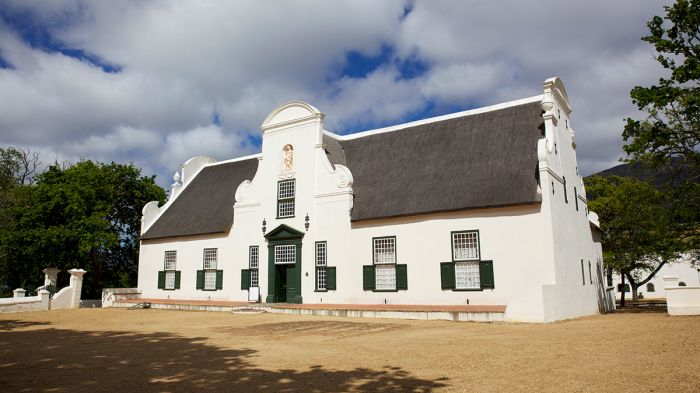
The original and historic manor house at Groot Constantia
Kirstenbosch Botanical Garden
This renowned national treasure was established in 1913 to showcase southern Africa's flora. The setting is spectacular on the eastern slopes of Table Mountain. The gardens grow more than 7 000 species and the Cape Floral Kingdom's fynbos vegetation are heavily featured, including plenty of proteas, ericas, and restios.

Walkway through Kirstenbosch Botanical Garden
Capetonians and tourists flock to Kirstenbosch in huge numbers and weekends can be somewhat crowded. There are numerous walking trails through the gardens, a Tree Canopy Walkway, known informally as the Boomslang (meaning tree snake), a cycad garden, the Bird Bath featuring a lovely stone pool and natural spring, a fragrance garden, a Braille trail, a sculpture garden, a medicinal plant garden, and two hiking trails up Table Mountain. Remnants of Van Riebeek's Hedge, the wild almond hedge planted by Jan van Riebeek in 1660, are preserved here.
Free 90-minute guided tours are offered daily except Sundays. The gardens host well-attended summer sunset concerts featuring a variety of music genres between November and April. The Galileo Outdoor Cinema screens movies every Wednesday and Thursday from October to April (movie starts after sunset weather permitting). There are three cafés, including the very good Kirstenbosch Tea Room.
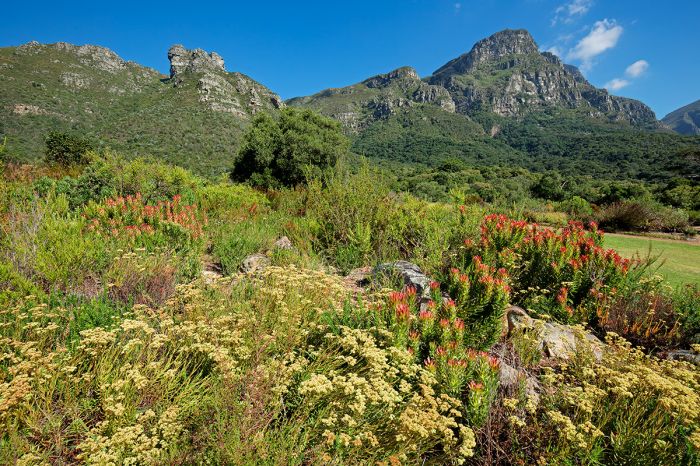
Flowers in Kirstenbosch with the peaks of Table Mountain as a backdrop
Hout Bay
Once a quaint fishing village, Hout Bay is now a major settlement. It's name, meaning 'Wood Bay', derives from its significance as a major source of timber during the colonial days. The town is still a functioning fishing harbor and is home to a healthy crayfish industry.
The popular and bustling Bay Harbour Market sells local crafts Friday thru Sunday. The bay is stunning, overlooked by Chapman's Peak and The Sentinel, although the beach here is not great and swimming should be avoided.
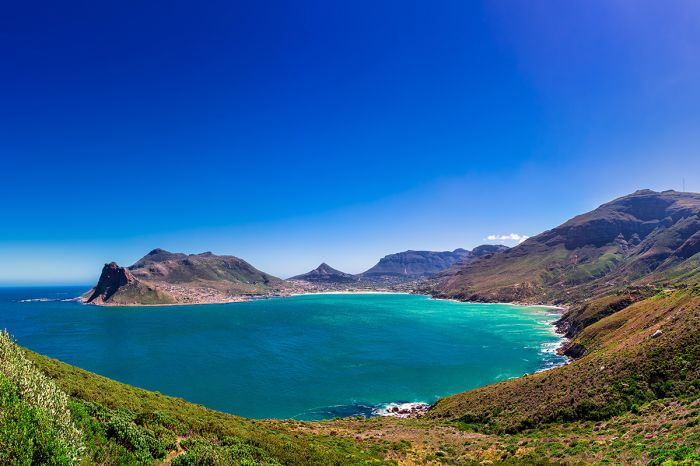
Hout Bay on the western side of the Cape Peninsula
Duiker Island lies just offshore and is home to a large Cape fur seal colony, boat tours available. Also offshore is "Dungeons", a renowned surfing spot known for its huge swells and the location of the annual Red Bull Big Wave Africa Surf Competition.
Chapman's Peak Drive
The spectacular Chapman's Peak Drive winds along the edge of the seaward cliffs between Hout Bay and Noordhoek. It is rightly recognized as one of the world's greatest stretches of coastal road. Constructed between 1910 and 1922, it was closed upgrades for four years starting in 2000 and re-opened in 2004 as a toll road. It was closed again for maintenance for most of 2008-2009 and it can be closed at any time due to rock slides. The drive is part of the annual Cape Argus, the world's largest timed bicycle race.
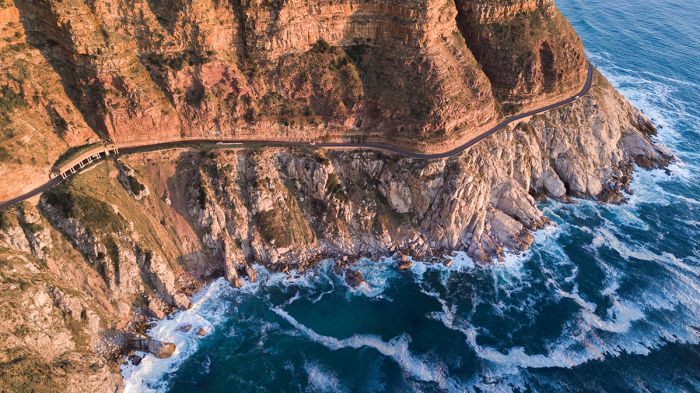
A portion of Chapman's Peak Drive winds along the coastal cliffs
Cape of Good Hope Reserve
The 30-sq-mile (77-sq-km) Cape of Good Hope Nature Reserve was proclaimed in 1939 to protect the southernmost portion of the Cape Peninsula. The reserve was incorporated into the greater Table Mountain National Park in 1999.
This section of the peninsula is the most breathtaking, terminating in a narrow point of rocky highland and cliffs at Cape Point. The views atop Cape Point are well worth the 20-minute hike up to the Old Lighthouse promontory (or you can ride the Flying Dutchman Funicular, leaving every 3 minutes). The popular Two Oceans Restaurant is located next to the car park and offers great vistas while having your breakfast or lunch (food adequate).
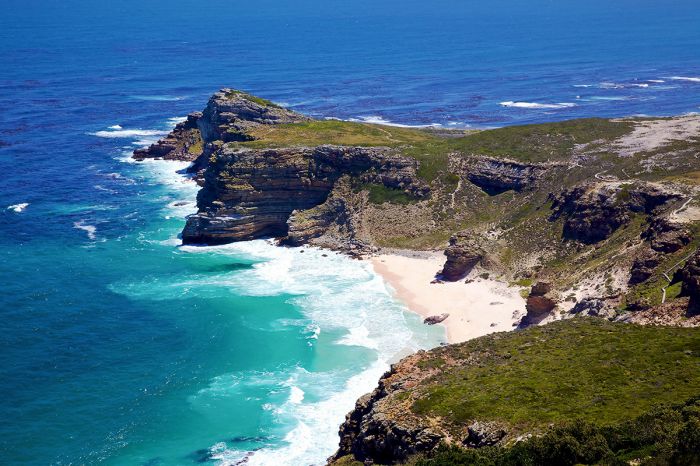
View from Cape Point looking over Diaz Beach and Cape of Good Hope
The more westerly Cape of Good Hope is a 45-minute walk from the Cape Point car park along a well-signposted trail. Between Cape Point and the Cape of Good Hope is the magnificent and secluded Diaz Beach (some fitness is required for the 20-minute hike down and 40 minutes back up).
The reserve is part of the Cape Floral Kingdom, with beautiful flowers and protea bushes and there are several good hiking routes. Driving slowly along the roads through the reserve may produce wildlife sightings, including ostrich, baboons, bontebok, red hartebeest, eland, Cape mountain zebra, grey Reebok, and grysbok. Note that one should keep a distance from baboons here if on foot and don't bring food if walking, as they can be very aggressive.
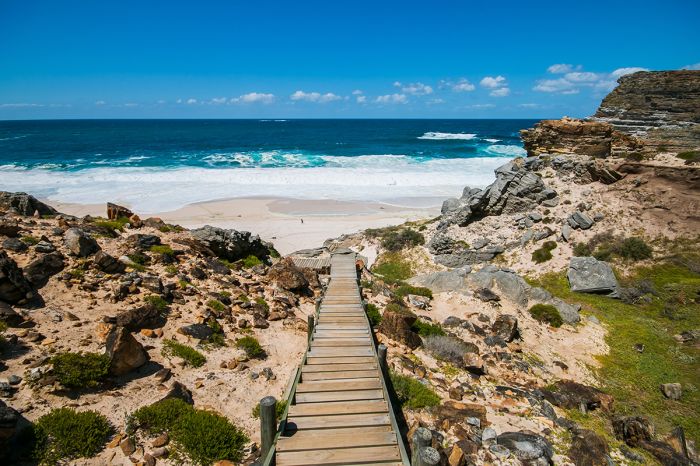
Entrance to Diaz Beach between Cape Point and Cape of Good Hope
Swimming along the coast here is not recommended due to the dangerous seas, but Buffels Bay and Bordjiesrif, midway along the eastern shore, both have have safe tidal pools and good picnic spots (keep a careful watch for baboons).
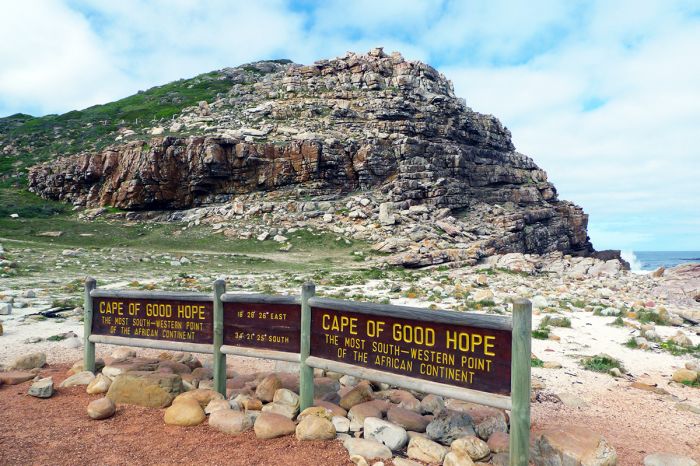
The Cape of Good Hope
Simon's Town
Modestly named after himself by Simon van der Stel, the first Governor of the Dutch Cape Colony, Simon's Town is the third oldest town in South Africa. It was founded in 1687 by the Dutch East India Company as an alternate wintering harbor to Table Bay. The English landed here in 1795 before defeating the Dutch at the Battle of Muizenberg and the town served as the base for the Royal Navy from 1814 to 1957, when it was passed to the South African Navy.
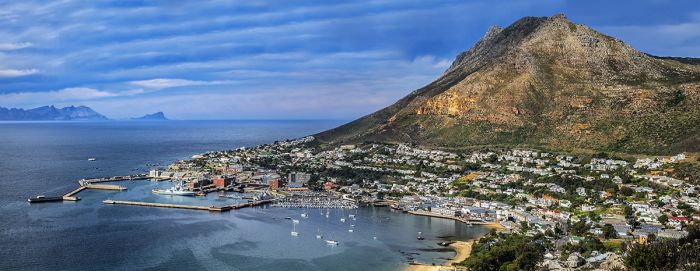
Simon's Town and the harbor on False Bay, Cape Peninsula
Simon's Town is a very pretty place and today there are still a wealth of Victorian-style buildings in town, especially along George Street's Historic Mile, the main thoroughfare through town. The still-functioning naval dockyard ruins some of the town's charm, but this plus glimpses of naval squaddies in their white uniforms gives it a distinct nautical feel.
Boulders Beach is a major attraction and the reason most tourists come to Simon's Town. The beach is home to a permanent colony of super-cute and endangered African penguins, which can be viewed from a walkway and platform. The colony was establish by just two breeding pairs in 1982, but today there are several thousand penguins living here. Just north of Boulders is Seaforth Beach, which has great swimming and usually some of the penguins too!
The Simon's Town Museum and the South African Naval Museum are both worth consideration.
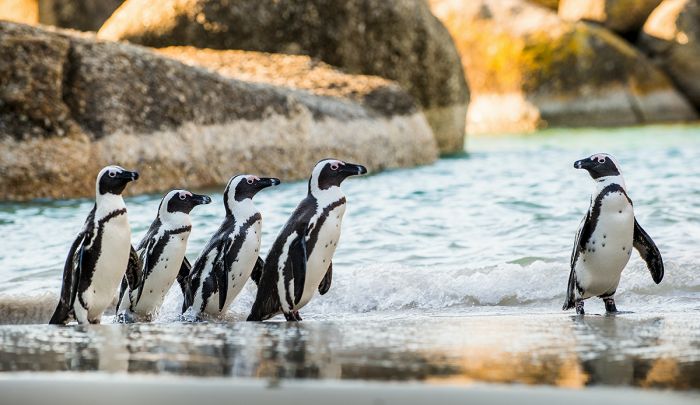
African penguins on Boulders Beach
Fish Hoek, Kalk Bay & Muizenberg
These three municipalities are essentially connected to each other as one contiguous stretch of coastal development, serviced by the coastal road and rail line which connects Cape Town's city centre to Simon's Town.
Fish Hoek beach was an informal fishing and whaling village that appears on the earliest maps of the Cape, but it was only proclaimed a formal township in 1918. Today its prime attraction is the wonderful, family-friendly beach, which offers moderately warm water and swimming.
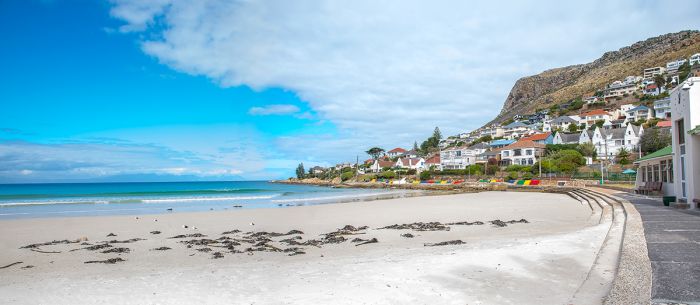
Fish Hoek beach
Kalk Bay, although smaller, is very popular with Capetonians and tourists for its mountain views and picturesque old fishing harbor complete with romantic wooden boats. Adding to the small town's charm are a bustling fish market, cobbled streets, excellent seafood eateries, antique dealers, curio shops, galleries, and the welcoming bunch of habituated Cape fur seals. The town's name derives from an early industry that baked seashells in large kilns to produce lime ('kalk' in Afrikaans).
Kalk Bay's residents are an eclectic mix of colored fishermen, artists, surfers, yuppies, creative trendies, and old folk. Whale watching is very good and the gentle giants often come very close to shore during the months of July thru September.
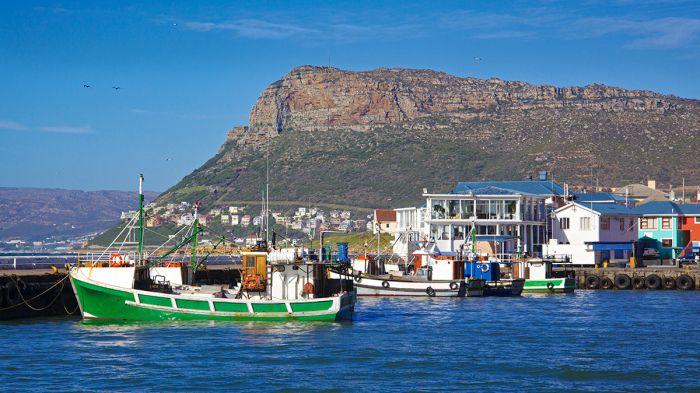
Fishing boats in Kalk Bay harbor
Located between Kalk Bay and Muizenberg is the much-photographed St James Beach with its multi-colored, Victorian-style changing chalets. The town itself is upmarket, with homes built into the mountainside. The twenty-minute walk along the coastal footpath that runs all the way to Muizenberg is spectacular, with panoramic views of the entirety of False Bay. Keep an eye out for whales and fur seals.
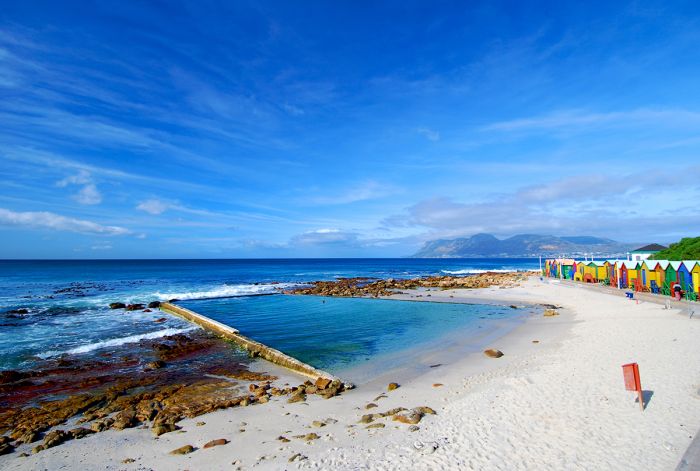
Tidal pool at St James beach
Muizenberg was once South Africa's most fashionable seaside resorts. That has changed, but the brightly colored Victorian changing chalets are a charming reminder of its heyday. Today Muizenberg still has the most popular surfing and swimming beach on the peninsula, which can be packed on weekends and during local school holidays, but relatively quiet at other times. National Geographic named Muizenberg one the world's twenty best surfing towns in 2017.
The popular Historical Mile, a short stretch of Muizenberg's shoreline should be strolled to see the notable buildings. Muizenberg Railway Station, a lovely Edwardian-style building complete with a beautiful and ornate clock tower, is now a National Monument. Het Posthuys ("the post house") was constructed by the Dutch East India Company in 1673 and is purported to be the oldest European edifice in the country. Rhodes' Cottage Museum, purchased by Cecil John Rhodes in 1899 (he died here in 1902), contains some of his memorabilia.
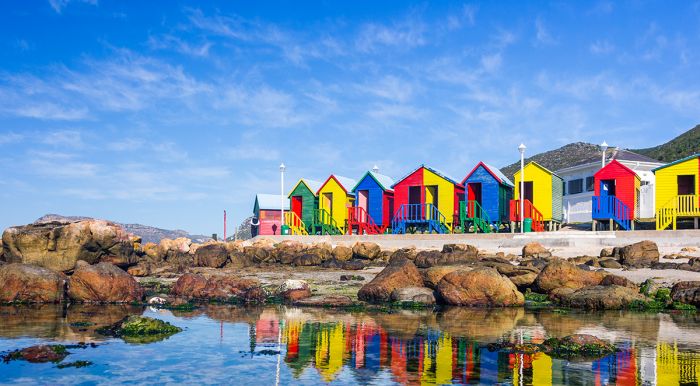
Colorful changing houses on Muizenberg beach
Shark Excursions
False Bay has historically been one of the best places in the world to see great white sharks. Shark expeditions, including shark-cage diving, leave from Simon's Town to Seal Island, which is home to 65 000 Cape fur seals. The shark season is generally mid-June through July. Sightings of great whites have been sporadic since 2017, but sevengill cow sharks are frequently seen at Seal Island. Mako and blue sharks are often seen at excursions to Cape Point. The other location for white shark cage diving is Gansbaai on the Whale Coast.
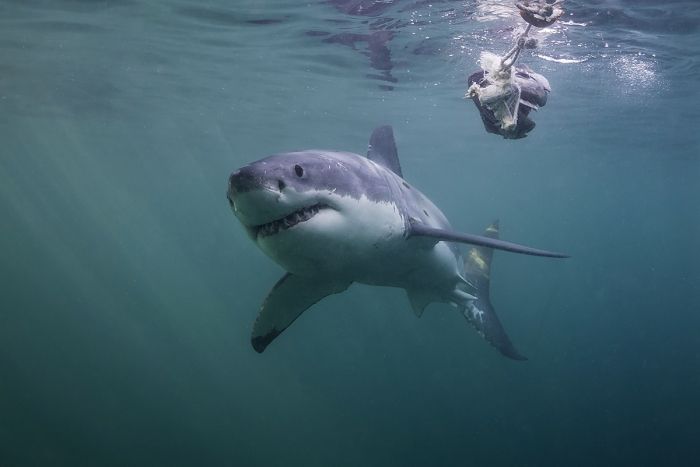
White shark viewed from a cape dive in False Bay
Beaches and Water Temperatures
The Cape Peninsula has an abundance of beautiful beaches that are renowned for having clean, powdery white sands. Some beaches are set in spectacular rocky or boulder-strewn bays or coves, while others are wide-open and stretch for miles.
While beautiful, be advised that the cold water temperatures are not conducive to spending hours swimming without a wetsuit. Beaches along the peninsula's Atlantic coast are influenced by the Benguela Current, which flows northward from the Antarctic and even in midsummer, the water temps average 50°-60°F (10°-15°C). The water on the False Bay side is typically 9°F (5°C) warmer. If you are looking for warmer waters, then the Garden Route, Eastern Cape, and Kwa-Zulu Natal coasts all enjoy lovely, warm Indian Ocean waters.
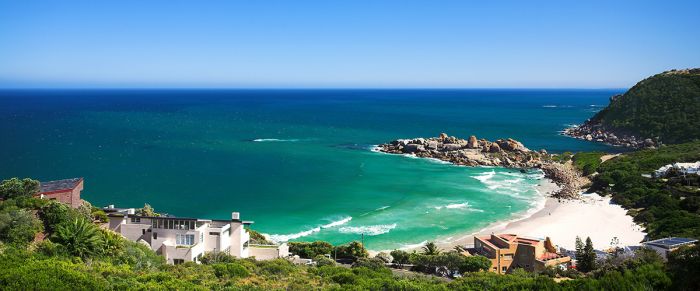
Llandudno beach on the Atlantic coast of the peninsula
Besides the cold water, wind is the other major factor that may affect a day at the beach. During the summer, howling winds out of the southeast, known as the Cape Doctor, are quite common and can spoil a beach day. On such days, opt for one of the small protected beaches on the Atlantic side, such as Llandudno or Clifton, which are sheltered by the mountains.
Generally speaking, beaches on the False Bay side are more crowded and sandwiched between the commuter rail line and the sea, the exception being Fish Hoek beach. South of Simon's Town, the beaches are wilder and much less crowded.
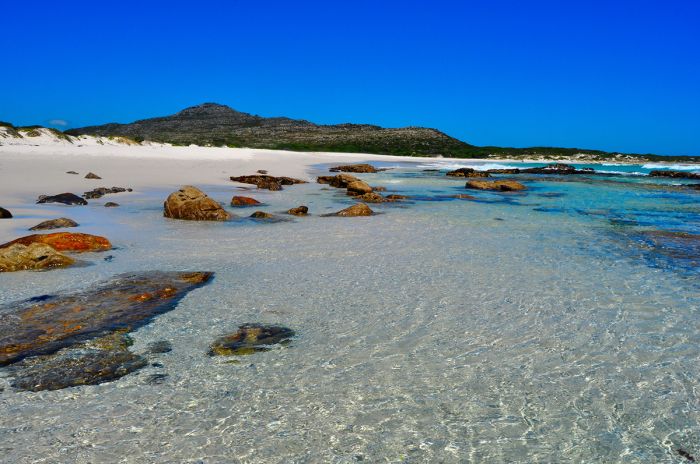
Scarborough beach on the Atlantic coast of the peninsula
Cape Floral Kingdom
The Cape Peninsula is a part of the Cape Floral Kingdom, the smallest of six globally recognized floral kingdoms which also has the highest relative diversity. A floral kingdom is a geographic area containing a relatively uniform composition of plant species.
The Cape Floral Kingdom spans from Clanwilliam on the northwest coast to Port Elizabeth along the Garden Route in the east. This region contains flora that is significantly different from the rest of the country, due mostly to its Mediterranean climate, coastal mountains, periodic fires, and a seasonal rainfall pattern that is opposite to that of the rest of South Africa. Most of the rain falls here during the winter months of May thru August, while the rest of the country experiences summer rains.
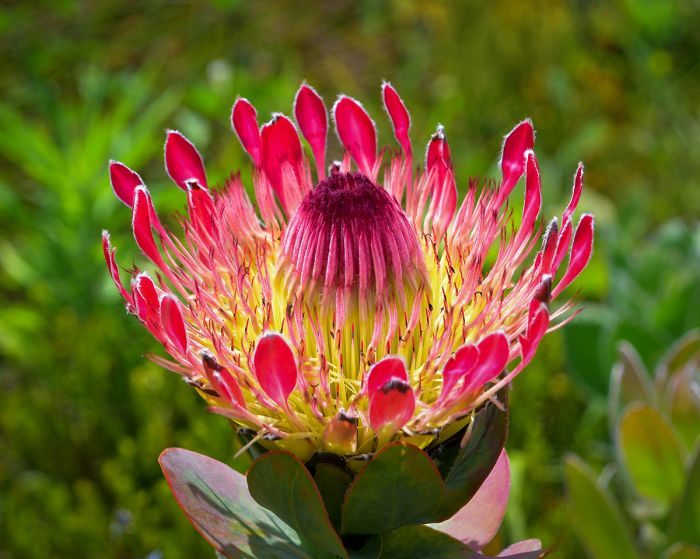
Protea eximia, one of many beautiful fynbos flowers
The dominant type of vegetation for the Cape Floral Kingdom is called fynbos, literally 'fine bush' in Afrikaans. The name comes from the thin leaves that are typical of many species of fynbos. Fynbos is an ancient shrub or heath vegetation with an exceptionally high degree of biodiversity and endemism, consisting of some 9 000 species, of which 6 500 are endemic. Over 80% of plant species in the region are classified as fynbos.
Most fynbos are unremarkable in appearance but there are exceptions, most notably the protea shrubs. Proteas (also called sugar bushes) have spectacularly colored flowers, many of which are pollinated by birds or small mammals. The largest is the King Protea, which has beautiful pink flowers up to 12 inches across.
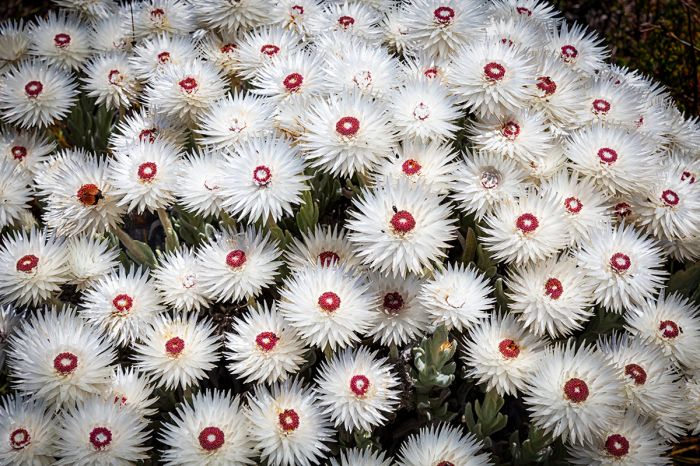
Syncarpha vestita, known as Cape Snow or Cape Everlasting
The Cape Floral Kingdom was inscribed as a UNESCO World Heritage Site in 2004. There are eight discrete protected areas within the kingdom, with Table Mountain National Park being the most accessible.
Six bird species are regarded as fynbos endemics, including the Cape sugarbird, which feeds primarily on nectar from protea flowers. The other endemics include Victorin's warbler, Cape siskin, orange-breasted sunbird, Cape rockjumper, and protea canary.
Mammals associated with fynbos and whose range is primarily confined to the region include Cape mountain zebra, Cape grysbok, and bontebok. It was also the primary habitat of the quagga (a partially-striped zebra) and bluebuck (same genus as roan and sable antelopes), both of which were hunted to extinction by early European settlers.
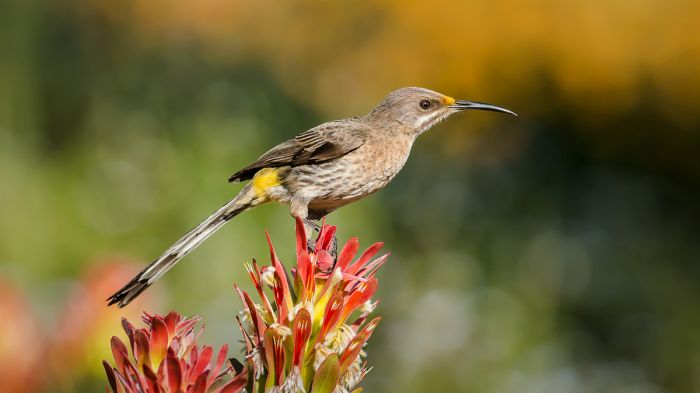
A male Cape sugarbird (Promerops cafer), one of the fynbos endemics
The Cape Flats and the Townships
The flat, sandy and windswept plains beginning on False Bay's northern shores and stretching all the way past the N2 in the north and east from the M5 highway highway past the airport are the Cape Flats.
The Flats are Cape Town's largest residential area and home to African townships, colored districts, and informal settlements called squatter camps. The sterility of this region meant that it remained almost totally uninhabited until the 1920s, in spite of being so geographically proximate to the city centre.
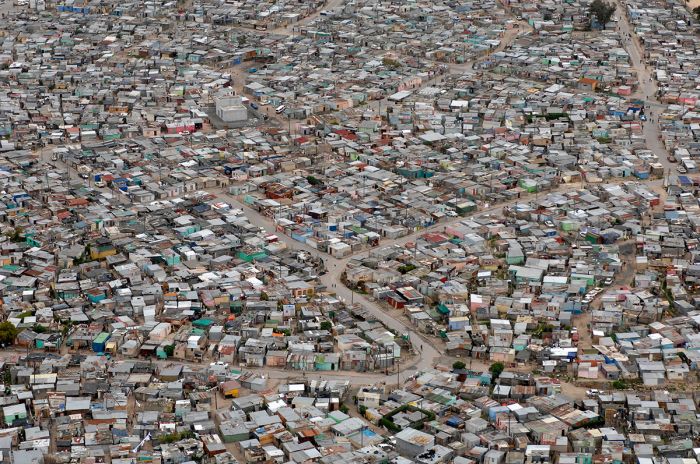
Aerial view over Khayalitsha Township
In 1927, Langa was established as Cape Town's first black township to accommodate the influx of African laborers from the Eastern Cape. This segregation trend continued through the apartheid era and the Cape Flats became the relocation grounds for tens of thousands of Cape Town residents who were forcibly removed as their homes were re-zoned into "Whites Only" areas.
The Flats were the dumping grounds for non-whites and became makeshift shanty lands with houses made of cardboard, iron, and plastic sheeting and eventually these became loosely organized into townships such as Mitchells Plain. During the 1970s and 1980s, the government tried to demolish the squatter towns, but as soon as the police vacated, the camps reappeared and today these squatter camps are a permanent feature of the Cape Flats.
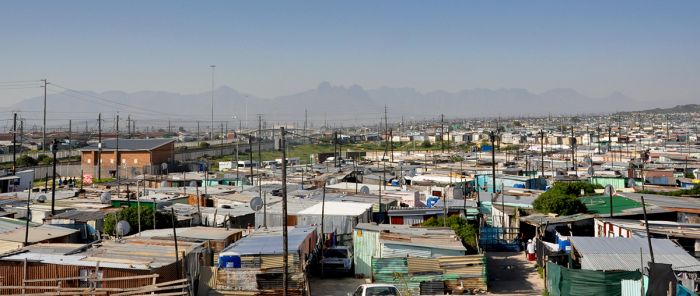
Khayalitsha Township with the Cape Peninsula mountains in the distance
Guided tours are available to the Cape Flats townships and they provide a contrast to the upscale southern suburbs of Cape Town and an insight into the lives of its residents. The most often visited are Langa (the first township), Gugulethu (established in the 1960s and called "Gugs"), and Khayalitsha (established 1983 with a fast-growing population of 2.5 million). Tours usually take a half day and visit one or two townships. Visiting the townships on your own is not recommended.

A little girl in Khayalitsha Township
Blouberg Beach
Located 6 miles (10 kms) north of the city centre along the R27, this long and beautiful beach is where the iconic post card photos of ocean with Table Mountain are taken. The mountain often looks blue in color from this vantage and thus the name Blouberg, meaning "blue mountain". The beach can be very windy and is especially popular for windsurfing, surfing, and kite surfing.
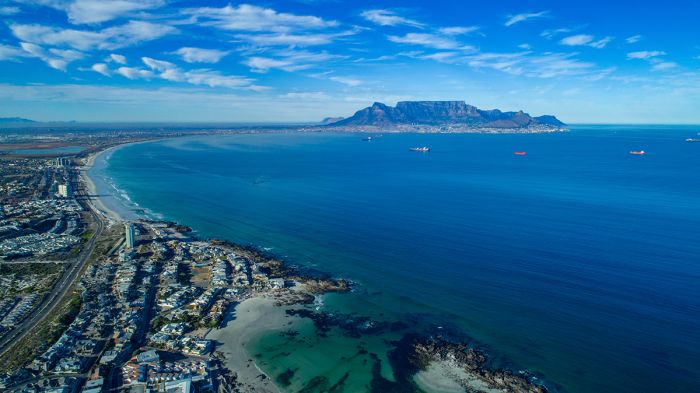
View from Bloubergstrand over Table Bay with Table Mountain in the distance
Durbanville Winelands
Located 15 miles (25 kms) northeast of the city centre, the Durbanville Valley has had vineyards since 1698. The valley and hills receive cool winds off the coast and this makes it perfect for growing white varietals, especially Sauvignon Blanc. There are 13 wine estates currently producing wines in the valley and its close proximity to the city make it a nice alternative to the better known Constantia region.
Our Winery Picks - Durbanville
- De Grendel: Established in 1720. Located on Tygerberg Hill w/incredible views of Table Mountain. Good restaurant. Superb Sauvignon Blanc.
- Durbanville Hills: Great views of Robben Island and Table Mountain. Known for its Merlot and Saibgnon blanc. Good restaurant.
- Hillcrest: Lots to do; good wines, tasty olives, nice restaurant, craft beers, pizzas in the beer garden, open air concerts, fishing in their quarry.
- Nitida: Award-winning wines from this tiny cellar. Two restaurants offering picnics and gourmet meals. Book ahead for tastings.
- Meerendal: Established in 1702. Excellent reds and whites. Beautiful Cape Dutch homestead. Art gallery, distillery, two good restaurants. Mountain biking trails.
- Signal Gun: Family-friendly. Good wines, craft beer, pizzas, biltong. Game drives on Hoogeberg Hill with eland, black wildebeest, zebras, etc.
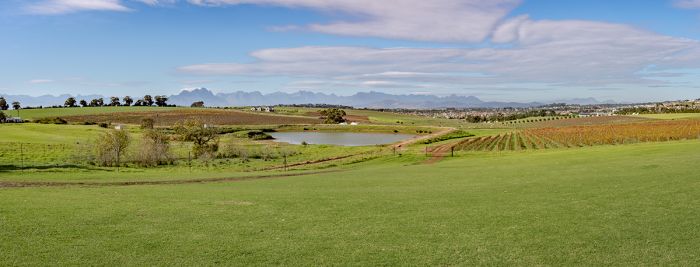
Meerendal Wine Estate in the Durbanville Valley northeast of Cape Town
Read more...
Beaches, Blouberg Beach, Cape Flats, Cape Floral Kingdom, Cape of Good Hope, Cape Peninsula, Cape Point, Cape Town, Chapman's Peak, Constantia Winelands, Durbanville Winelands, Fish Hoek, Hout Bay, Kalk Bay, Khayalitsha, Kirstenbosch Garden, Muizenberg, Robben Island, Sharks, Simon's Town, Table Mountain
Great Good Fair Poor
- Jan
- Feb
- Mar
- Apr
- May
- Jun
- Jul
- Aug
- Sep
- Oct
- Nov
- Dec
November thru February (Summer)
Contrasted with most of South Africa, the Cape Peninsula, experiences warm, dry weather during the summer (most of the country receives the majority of its rain in the summer). The Mediterranean climate enjoyed by the Cape means it receives most of its rain during the winter. Due to the wonderful summer weather, it is peak season in the Cape.
Locals and tourists flock to the beaches and summer events to enjoy the long (sunset is after 8pm), sunny days. Food and wine festivals are in full swing. Rain is rare to nonexistent and temps average between 63-82°F (17-28°C), but can reach as high as 104°F (40°C). The winds pick up on some days, but in general, the summer weather is lovely and perfect for the Cape Peninsula's treasure trove of outdoor activities.
The beautiful weather means flights and accommodation prices are a bit higher and attractions in the Cape are busier, so its advisable to book early if you plan to visit over the summer.
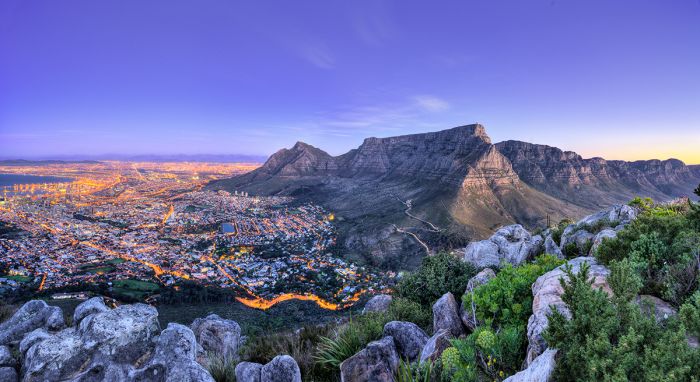
View over Cape Town and Table Mountain
March and April (Fall)
Spectacular autumn colors dominate the mountains and landscapes of the Cape and nearby wine lands. The weather is mostly nice but rains occur with more frequency. There are some major festivals held, including the Cape Town Cycle Tour and the Two Oceans Marathon. The week around Easter is best avoided due to increased crowds. Flights and accommodation around these events can be pricey and booked up far in advance. Plan around them if possible.
Temps are very pleasant at 59-81°F (15-27°C), but the first cold fronts can be expected in April. March typically experiences 2-3 rainy days and April 6 or 7 days of rain. Overall, there are less crowds except around the events discussed above.
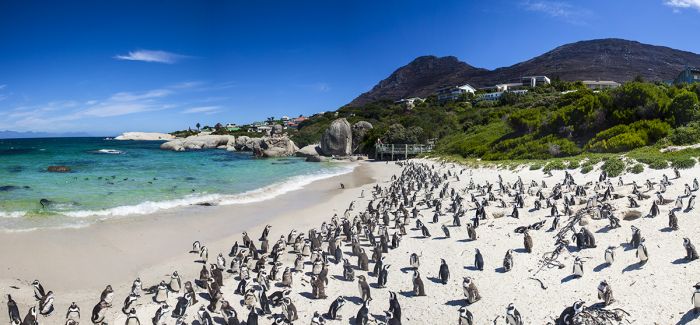
African penguins on Boulders Beach in Simon's Town, South Africa
May (late Fall)
In May the temps are dropping significantly and the first real rains arrive. Most days are chilly enough for a sweater with temps between 55-72°F (13-22°C). Accommodations are easy to find and attractions are easy to book, but the risk of rain means plans might be spoiled by the weather. One plus is that there are seldom any windy days, so on the rain-free days, the beaches are wonderful.
May typically receives 9-10 days of rain. Restaurants and hotels offer discounted prices.
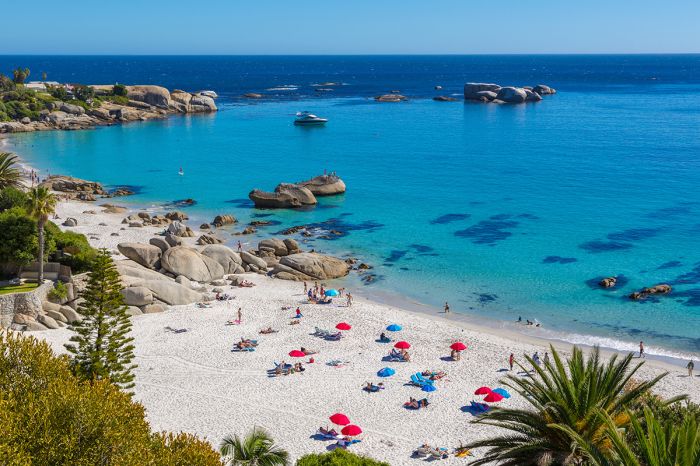
Camps Bay beach
June thru August (Winter)
These are the winter months and the weather is chilly and often rainy, which means crowds are nonexistent. Flights, accommodations and restaurants offer bargain pricing. Temps range between 52-68°F (11-20°C), but most days average 55°F (13°C). Each month experiences 10-12 rain days.
The landscape are spectacular and verdant, but rain can spoil outdoor activities. Table Mountain usually closes for two weeks at the end of July. The Winelands and hiking on the Peninsula are lovely on clear days. June and July are also great for whale watching and shark diving in False Bay.
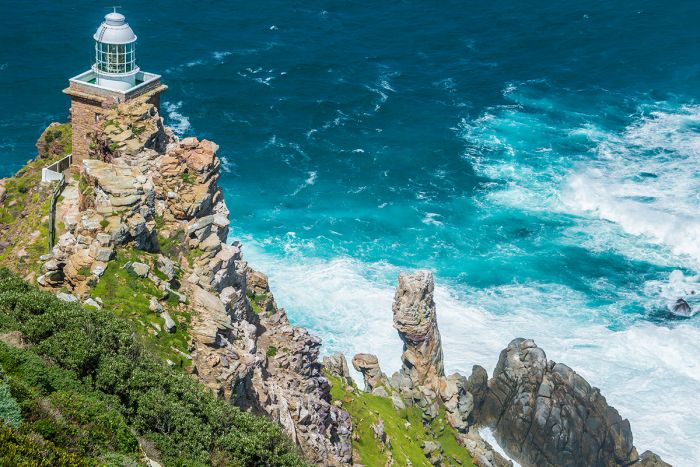
The "New" Cape Point lighthouse (the older lighthouse still exists on higher ground)
September and October (Spring)
Wildflowers are everywhere and the landscapes are spectacular, with hillsides, fields and mountains covered by brilliant splashes of color. The whales are still around and you may see lots of recently born calves swimming with their moms.
Rains are diminishing, with only 6-8 days of rain per month. Temps are also rising, ranging between 55-70°F (13-21°C) and the days are getting longer, providing more time to enjoy the outdoors. Winter accommodation specials are ending and prices at hotels and restaurants return to normal.
Music festivals and the Kirstenbosch outdoor movies start in October and this is one of the best times to visit the Cape.




